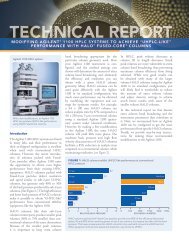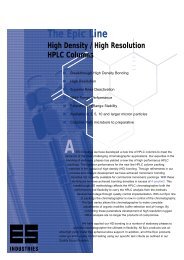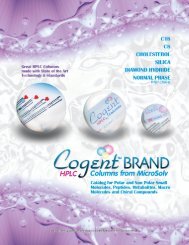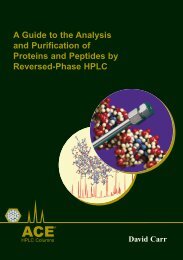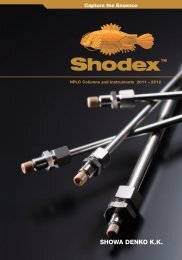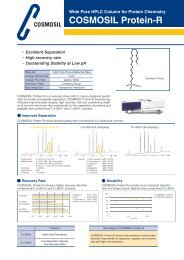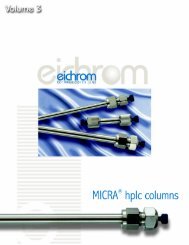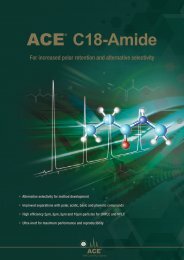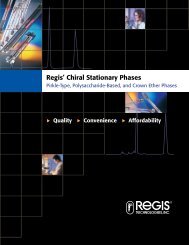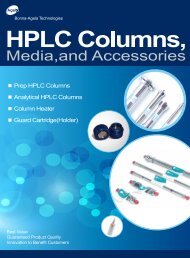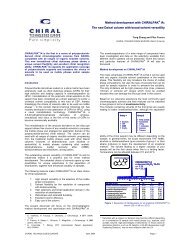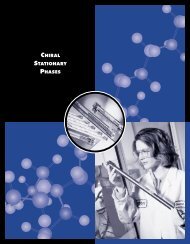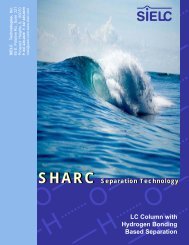A Guide to HPLC & LC-MS Buffer Selection - by John W ... - Hplc.eu
A Guide to HPLC & LC-MS Buffer Selection - by John W ... - Hplc.eu
A Guide to HPLC & LC-MS Buffer Selection - by John W ... - Hplc.eu
You also want an ePaper? Increase the reach of your titles
YUMPU automatically turns print PDFs into web optimized ePapers that Google loves.
and organic solvent initially contact each other in the mixer. In the example cited<br />
earlier, a 10 mM potassium phosphate, pH 7.0 buffer in 60% ACN would be<br />
soluble in bulk solution, but would require 25 mM phosphate in the A-reservoir.<br />
When 25 mM phosphate contacts 100% ACN in the mixer, precipitation may occur.<br />
An alternative way <strong>to</strong> blend the solvents in the example above would be <strong>to</strong> put<br />
10 mM phosphate in the A-reservoir. For the B-solvent, hand-mix 70% ACN<br />
with 30% of a 33 mM phosphate buffer solution <strong>to</strong> achieve 70% ACN<br />
containing 10 mM phosphate (half the critical concentration of Table 3). Now<br />
the A- and B-solvents can be blended <strong>to</strong> achieve 60% ACN with a final<br />
concentration of 10 mM phosphate. This technique avoids the potential of<br />
precipitation of buffers within the <strong>HP<strong>LC</strong></strong> and allows the flexibility <strong>to</strong> mix online<br />
any mobile phase containing 70% ACN or less. It has the added advantage for<br />
gradient work that the concentration of buffer will be constant throughout the<br />
gradient, so dilution of the buffer during the gradient should not be a concern.<br />
<strong>Buffer</strong> Preparation<br />
There are four common techniques <strong>to</strong> prepare buffers that are reviewed briefly<br />
here. <strong>Buffer</strong> recipes are plentiful, so they have not been reproduced. Many<br />
biochemistry and chemistry texts contain tables of buffers; one handy<br />
compilation of buffer recipes for <strong>HP<strong>LC</strong></strong> is contained in the appendix of [3]. An<br />
excellent on-line <strong>to</strong>ol [4] prompts for the target buffer pH, concentration and<br />
volume and then generates a recipe.<br />
The best way <strong>to</strong> prepare buffers is <strong>to</strong> weigh the buffer components according <strong>to</strong><br />
the recipe and dilute them with water <strong>to</strong> the desired volume. At first this may<br />
seem like a tedious procedure, but it is more accurate, usually is faster than pHadjustment<br />
techniques and is easy <strong>to</strong> reproduce over time and from lab <strong>to</strong> lab.<br />
This technique delivers a buffer of the desired concentration and pH. It is a<br />
good idea <strong>to</strong> check the pH after formulation <strong>to</strong> ensure no mistakes were made.<br />
An alternative buffer preparation technique is <strong>to</strong> make separate solutions of the<br />
acidic and basic buffer components (e.g. phosphoric acid and the phosphate salt<br />
at 10 mM each). The two solutions are blended and the pH is moni<strong>to</strong>red with a<br />
pH meter until the desired pH is reached. This gives a buffer of the desired<br />
concentration and with a pH as close as the pH meter can read (usually ±0.1 pH<br />
units in general use).<br />
A variation on blending equimolar solutions of acid and base is <strong>to</strong> make up one<br />
component at the desired concentration (e.g. the phosphate salt at 10 mM) and<br />
titrate with concentrated acid (e.g. phosphoric acid) until the desired pH is<br />
12 www.ace-hplc.com



